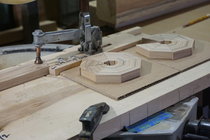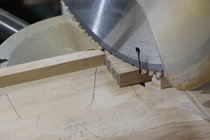Team, I appreciate all the help I've gotten lately. I forgot I had Tibbet's book on segmented turnings but remembered that he prefers using a compound slider instead of a tablesaw. I was asking around about a tablesaw jig and really had forgotten about the miter saw option.
I have a 12" Hitachi non-slider that is just a common Lowes saw but has served me well running crown molding.
I feel like this will suffice. I have PLENTY of MDF at my disposal to make sacrificial miter fences with.
The segments obviously will never be so large that the 12" won't suffice for width. Is there any reason a slider is necessary in your experience?
My goal is to begin learning how to do segmented turnings, so I'm only going to be cutting simple ring layers for now, not complex symbols or patterns.
I have a 12" Hitachi non-slider that is just a common Lowes saw but has served me well running crown molding.
I feel like this will suffice. I have PLENTY of MDF at my disposal to make sacrificial miter fences with.
The segments obviously will never be so large that the 12" won't suffice for width. Is there any reason a slider is necessary in your experience?
My goal is to begin learning how to do segmented turnings, so I'm only going to be cutting simple ring layers for now, not complex symbols or patterns.


